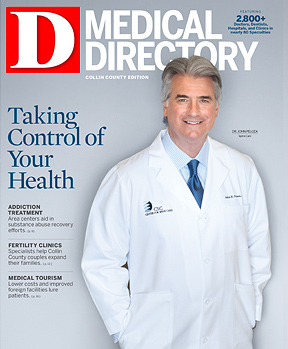At first glance, Michelle Pelzel doesn’t appear to be someone who has struggled with fertility issues. With her newborn twin boys and toddler daughter in tow, she’s fully immersed in the joys of motherhood.
The Plano mom’s situation has changed dramatically from three years ago, when her biological clock was loudly ticking. After trying to become pregnant for a year, Pelzel, then 26, and her husband, Terry, decided it was time to see a fertility specialist.
“We didn’t tell people we were trying, but we ended up having dinner with some friends and they were pregnant at the time,” Pelzel says. When the couple shared that they had found help from a Plano fertility doctor, the Pelzels told them they were in the same situation.
Many of the Collin County-based fertility clinics rely on such referrals to attract the area’s younger, well-educated demographic. Collin is the wealthiest county in Texas, and one of the fastest-growing in the country. In 2011, the population rose 3.8 percent to 812,226, according to the U.S. Census Bureau.
“Collin County is one of most densely populated fertility centers in the nation,” says Dr. Alfred Rodriguez, medical director of the Assisted Reproductive Technologies Department at Texas Health Presbyterian Hospital Plano, which was one of the first hospital-based clinics to open in Collin County in 1996. “There’s a lot of competition in the area.”
Where To Start
Choosing the right facility can be a challenge for patients who are new to the world of technological advances in fertility treatments. Pelzel started her search online, but ultimately it was her friends’ experience that cinched the deal.
“Having the referral—somebody’s who has been there—is what sold us,” she says. “It’s one of those things that you’re almost embarrassed about. It’s not a situation you want to be in in the first place.”
After consulting with Rodriguez and his “incredible” staff, Pelzel says she knew it was a good fit. Some clinics advocate a get-pregnant-fast strategy using drugs right away, but Rodriguez’ approach considered other underlying health conditions that might be blocking conception. He determined Pelzel should have surgery for her endometriosis, which can cause fertility issues when the cells from the lining of the uterus grow in other areas of the body.
“We felt confident that fixing the problem first and then going through the treatments was the right thing to do,” she says.
Age Matters
Although it may seem like you need a medical degree to decipher all of the treatment options, much is determined by the age of the female and any ovulatory issues she is experiencing.
Most patients start basic treatment with their general obstetrics/gynecology doctor. They typically seek out a fertility clinic when those measures fail to produce a pregnancy.
The optimal age for pregnancy is 25. For patients younger than 30, a year of infertility is reasonable, as long as no other health problems exist; for women over 35, six months is normal.
Fertility success rates drop with age. When a female is born, she has 1 million to 2 million eggs in her ovaries. When puberty hits, she’s down to 300,000. By the age of 37, she has about 25,000 eggs that have been there since the beginning. In contrast, men make new sperm every two to three days.
Fertility clinics are seeing more women over 35 attempting to conceive their first babies later in life. Many have delayed motherhood for educational or professional reasons, with some not realizing they’ve waited too long to try to conceive.
If a female has a poor prognosis with her own eggs, egg donation is a viable and popular option. The procedure has a 70 percent to 80 percent success rate with one cycle of in vitro fertilization, or IVF. The disadvantage is that the baby doesn’t carry the mother’s genetics.
On the upside, she’s the mother of gestation, lactation, and rearing the child.
“Three out of four isn’t bad,” Rodriguez says.
Types Of Procedures
At the Dallas IVF clinic in Frisco, the average new patient is about 34 years old, says Dr. Brian D. Barnett, medical director.
The most common procedures performed at the clinic are artificial insemination, combined with oral or injectible fertility medications, such as clomid or gonatropins therapy. The medications can help a woman develop a follicle and ovulate a mature egg. Sperm is then collected from a partner and transferred into the uterus using a small catheter. The goal is to produce two to three eggs and time their release with insemination.
Artificial insemination is more conservative and less expensive than other procedures like IVF. Artificial insemination is most appropriate for women under the age of 35 who have passed an ovarian reserve egg assessment, which determines the aggressiveness of treatment.
Many patients will undergo several rounds of artificial insemination before choosing the IVF option. Success rates for IVF are 55 percent to 70 percent in patients younger than 35, about 50 percent for those 38-40, and less than 20 percent for those over the age of 40, Rodriguez says.
Most insurance companies don’t cover artificial insemination or IVF, costing patients as much as $15,000 to $20,000 per procedure. Fertility office visits, consultations, and related surgeries are usually covered expenses.
It took about a year from her first appointment before Pelzel tried artificial insemination—twice, unsuccessfully. She got pregnant on her first IVF and had her daughter, Kylie, about 19 months ago. She didn’t wait long before trying another IVF, which resulted in her twin sons, Ethan and Jaxson.






